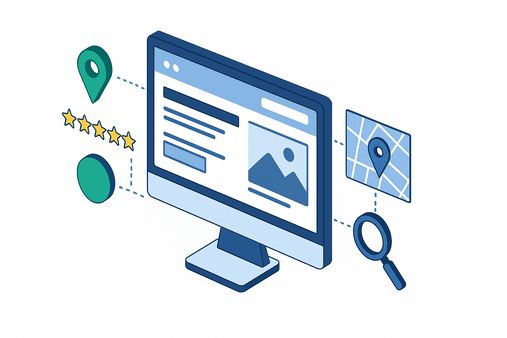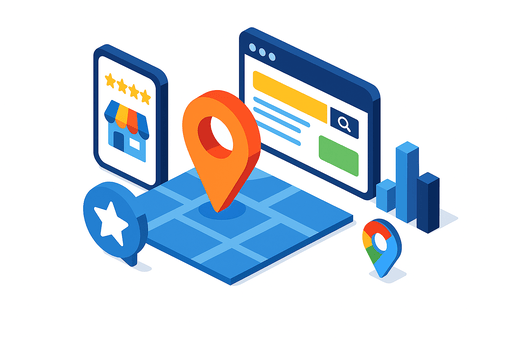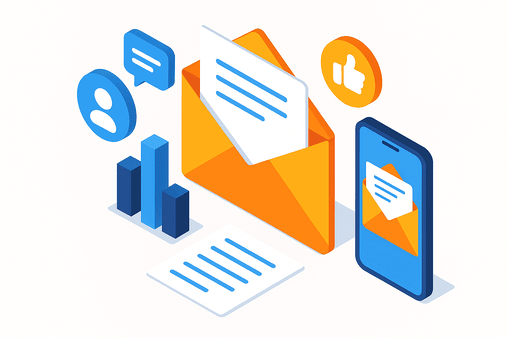
Your Starter Guide to Digital Marketing for Your Business
What Is Digital Marketing?
Digital marketing is the umbrella term for all online activities used to promote a business, connect with potential customers, and grow a brand. It includes everything from your company website and search engine optimisation (SEO), to social media campaigns, email newsletters, paid advertisements, and more.
In today’s world, the majority of buying decisions start online — even if the final purchase happens in person. Whether someone is searching for a solution on Google, browsing reviews, or checking out your Instagram, digital marketing is what makes sure your business shows up in those crucial moments.
At its core, digital marketing is about visibility. It’s the engine that drives awareness, interest, and — ultimately — leads and sales. When it’s done well, it helps you:
-
Attract the right audience – people who are actively looking for what you offer
-
Build trust and credibility – through helpful content, positive reviews, and consistent branding
-
Convert visitors into leads or customers – by guiding them through a well-structured journey
The beauty of digital marketing is that it’s measurable, adaptable, and scalable. You can start small, learn what works, and grow your efforts over time.
Why Your Website Is Your Most Valuable Asset
Your website is more than just an online presence — it’s your digital storefront, your 24/7 salesperson, and often the very first point of contact someone has with your business. Whether that visitor comes from a Google search, a paid Facebook ad, or a direct referral, their impression of your site often becomes their impression of your company.
And here’s the thing — people decide quickly. Within seconds, they’re making judgments about whether your business is credible, professional, and trustworthy, all based on what they see and experience on your site.
That’s why it’s essential to ask:
-
Does your site load quickly, on both desktop and mobile devices?
-
Is it mobile-friendly, with a responsive layout that adapts to any screen size?
-
Is the navigation clear, so users can find what they need without frustration?
-
Does it clearly explain what you do, and who your services are for?
-
Are your contact details easy to find, with calls to action placed throughout?
-
Does the design reflect your brand, and build trust from the first scroll?
Even small improvements — like faster page speeds, better images, or more prominent enquiry buttons — can have a big impact on how many visitors turn into actual leads.
We’ve seen businesses double their online enquiries simply by refreshing their website layout, rewriting key pages, and improving the mobile experience.
So if you’re investing time and money into digital marketing, make sure your website is ready to receive that traffic — because if it isn’t, you could be losing leads before they even get in touch.
The Power of Local SEO
Local SEO is one of the most overlooked opportunities in digital marketing — especially by businesses that don’t consider themselves “local.” But whether you’re a high-street coffee shop or a national B2B service provider, there’s a huge benefit in being visible to people in your immediate area.
Think about it: even remote-first companies serve specific regions, postcodes, or cities. And when people in those areas search for services you offer, they’re far more likely to engage with businesses that appear local and credible.
Here’s why local SEO matters:
-
Local search listings often appear before organic results, especially on mobile. That means you can outrank national competitors simply by showing up in the local pack.
-
Google Business Profiles (formerly Google My Business) give you prime visibility — complete with maps, photos, reviews, and opening hours.
-
Star ratings and customer reviews are one of the most trusted decision-making tools online. A well-reviewed local listing can build trust at a glance.
-
“Near me” searches are exploding. Queries like “IT support near me” or “best accountant in Brighton” are intent-rich and conversion-ready.
Even if your business doesn’t rely on foot traffic, having a well-optimised Google Business Profile can drive more enquiries, improve your visibility, and reinforce your reputation in the eyes of prospective clients.
Getting started is easier than you think:
-
Claim and verify your Google Business Profile
-
Add accurate service information, photos, and contact details
-
Regularly update your listing with posts and offers
-
Ask happy clients to leave a review after every project
Local SEO isn’t just about being found — it’s about being trusted. And in today’s digital-first world, trust often starts with a five-star rating.
Paid Ads: Speed Up Your Results
SEO and content marketing are powerful, long-term strategies — but they require patience. It can take months to build momentum, climb the search rankings, and start generating organic leads.
But what if you need results now?
That’s where paid advertising comes in. When done right, it gives you instant visibility, immediate traffic, and — most importantly — fast feedback on what works. Paid ads can help you test messaging, attract ready-to-buy customers, and scale up quickly once you find what converts.
There are several platforms to choose from, and the best one depends on your goals and audience:
-
Google Ads – Ideal for targeting people actively searching for your service. If someone types “emergency IT support in Brighton” into Google, they’re ready to act — and you can appear at the top of that results page.
-
Facebook & Instagram Ads – Best for increasing brand awareness, promoting offers, and retargeting visitors who didn’t convert the first time. Great for B2C or service businesses with strong visuals and messaging.
-
LinkedIn Ads – Tailor-made for B2B businesses. You can target decision-makers by job title, industry, or company size — perfect for professional services or niche offerings.
-
YouTube Ads – Great for storytelling, brand recall, or showcasing products in action. If you have video content, YouTube lets you put your message in front of highly targeted audiences based on interests and behaviours.
The key to successful paid advertising isn’t just spending money — it’s spending it wisely. Start with a small, focused campaign. Track your results. Refine your message and targeting. Then scale up what’s delivering leads.
And remember: it’s not just about traffic. It’s about qualified traffic that turns into real enquiries, bookings, or sales.
Email Marketing: An Underappreciated, High-ROI Channel
Email might not be the newest digital marketing tactic — but it remains one of the most effective. While social media platforms come and go, and ad costs continue to rise, email offers something rare: direct, permission-based communication with people who actually want to hear from you.
Why is email so powerful?
-
You own your list. Unlike social media followers or ad audiences, your email subscribers are yours — no algorithms, no pay-to-play.
-
It’s personal and targeted. You can segment your audience and send the right message at the right time, whether it’s a promotion, a useful tip, or a gentle nudge to book.
-
It consistently delivers ROI. Study after study shows that email marketing returns more than £30 for every £1 spent — higher than nearly any other channel.
Types of Email Marketing Campaigns
You don’t need a complicated setup to get started. Here are a few proven email types that work for almost any business:
| Type | Purpose |
|---|---|
| Welcome emails | Make a strong first impression. Let new subscribers know what to expect and how you can help them. |
| Monthly newsletters | Share useful content, company updates, or case studies. Stay top of mind with your audience. |
| Follow-up sequences | Automate a series of emails to re-engage leads who didn’t convert, or upsell existing customers. |
The best part? Once your email campaigns are built, they keep working in the background. One well-timed message could bring in a new customer every week — without you lifting a finger.
As your list grows, so does your ability to nurture relationships, build loyalty, and drive repeat business — all at a fraction of the cost of other marketing methods.
Know What’s Working: Analytics & Tracking
Digital marketing gives you access to more data than ever before — but without the right focus, all that information can feel overwhelming. The key is not to track everything, but to track the metrics that actually matter to your business goals.
Because if you’re not measuring performance, you’re essentially flying blind. You won’t know what’s working, what needs improvement, or where to invest your time and budget.
Start by defining your objectives. Then, choose a few meaningful metrics that align with those goals.
Here are some core metrics worth watching:
-
Contact form submissions – A direct indicator of leads coming through your website. Track how changes in layout, headlines, or traffic sources affect enquiry rates.
-
Email open and click-through rates – Help you gauge whether your email marketing is engaging and effective. Low open rates? Time to test new subject lines. Low clicks? Try adjusting your call-to-action or layout.
-
Website traffic sources – Understand where your visitors are coming from (Google, social media, email campaigns, paid ads) so you can double down on the channels that perform best.
-
Conversions from paid campaigns – It’s not about how many clicks your ads get — it’s about what happens after the click. Are users buying, booking, or getting in touch?
You don’t need a data science degree to monitor your results. Tools like Google Analytics, Google Tag Manager, HubSpot, and Mailchimp make it easier than ever to track user behaviour, set up conversion goals, and generate reports you can actually use.
The secret to success isn’t having more data — it’s having the right data, in the right place, with clear next steps.
Where Should You Start?
Not sure where to begin? You don’t need to do everything at once. Start with the channel that matches your goals:
| Goal | Start With |
|---|---|
| More leads quickly | Google Ads or Facebook Ads |
| Long-term growth | SEO and content marketing |
| Better local visibility | Google Business Profile |
| Stronger first impression | Website optimisation |
| Keeping leads warm | Email marketing automation |
Final Thoughts: Consistency Over Complexity
One of the biggest misconceptions about digital marketing is that you need to do everything, all at once, to see results. But in reality, success is rarely about complexity — it’s about consistency.
You don’t need the biggest budget, the flashiest website, or a full-time marketing team to make progress. You just need to take the right steps, in the right order, and keep going.
Here’s where to focus:
-
Improve your website – Make sure it’s fast, mobile-friendly, and clearly communicates what you do. Even small tweaks — like better calls to action or cleaner layouts — can lead to big improvements in conversions.
-
Get visible locally – Claim your Google Business Profile. Ask for reviews. Optimise for “near me” searches. Local trust goes a long way, even for national or online-only businesses.
-
Start building your audience – Use email to stay connected. Share useful content. Be the brand people remember when they’re ready to buy.
-
Test ads to speed things up – Run small paid campaigns to generate leads or test what messaging resonates. The data you gather now will help guide your long-term strategy.
Most importantly: track what works. The only way to improve is to measure your results, learn what drives performance, and do more of it.
Digital marketing isn’t a one-off project — it’s a habit. And like any good habit, the results compound over time.
Start simple. Stay consistent. And don’t be afraid to ask for help.
💬 Need help putting this into action? Talk to our team.






